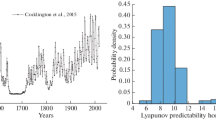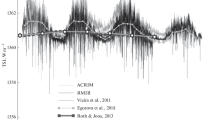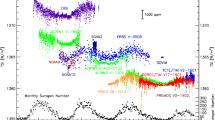Abstract
Reconstruction and forecasting the data series of total solar irradiation (TSI) is one of the most urgent scientific problems at the moment. In this paper, we review three reconstructions of TSI based on the data of cosmogenic 14C and 10Be isotopes and sunspots and tested their predictability by a modified analog method for a one-step prediction of decadal averages. The data of cosmogenic isotopes allow us to estimate changes of the open magnetic flux of the Sun, the magnitude of which is indirectly associated with TSI changes. We establish that the quality of the TSI forecast decreases if we consider a composite timeseries compiled from different data sources. In particular, the analog method does not work for reconstruction, various parts of which were recovered according to cosmogenic isotopes, the number of sunspots, and also according to modern satellite observations. However, at the same time, it operates for reconstructions recovered using cosmogenic isotopes for the whole series. Thus, the predictability of the series manifests the presence of a nonlinear deterministic component and is one of the criteria of the quality of reconstructions.



Similar content being viewed by others
REFERENCES
Delaygue, G. and Bard, E., An Antarctic view of Beryllium-10 and solar activity for the past millennium, Clim. Dyn., 2011, vol. 36, nos. 11–12, pp. 2201–2218.
Farmer, J.D. and Sidorowich, J.J., Predicting chaotic time series, Phys. Rev. Lett., 1987, vol. 59, pp. 845–849.
Georgieva, K., Nagovitsyn, Y., and Kirov, B., Reconstruction of the long-term variations of the total solar irradiance from geomagnetic data, Geomagn. Aeron. (Engl. Transl.), 2015, vol. 55, no. 8, pp. 1026–1032.
Kopp, G., Lawrence, G., and Rottman, G., The Total Irradiance Monitor (TIM): Science results, Sol. Phys., 2005, vol. 230, pp. 129–139.
Krivova, N.A., Balmaceda, L., and Solanki, S.K., Reconstruction of solar total irradiance since 1700 from the surface magnetic flux, Astron. Astrophys., 2007, vol. 467, no. 1, pp. 335–346.
Li, K.J., Yun, H.S., and Gu, X.M., On long-term predictions of the maximum sunspot numbers of solar cycles 21 to 23, Astron. Astrophys., 2001, vol. 368, no. 1, pp. 285–291.
Lockwood, M., Owens, M.J., Barnard, L., et al., An assessment of sunspot number data composites over 1845–2014, Astrophys. J., 2016, vol. 824, id 54.
Petrovay, K., Solar cycle prediction, Living Rev. Sol. Phys., 2010, vol. 7, no. 1, id 6.
Preminger, D.G. and Walton, S.R., A new model of total solar irradiance based on sunspot areas, Geophys. Res. Lett., 2006, vol. 32, no. 14.
Rahmanifard, F., Schwadron, N.A., Smith, C.W., et al., Inferring the heliospheric magnetic field back through Maunder minimum, Astrophys. J., 2017, vol. 837, no. 2, id 165.
Roth, R. and Joos, F., A reconstruction of radiocarbon production and total solar irradiance from the Holocene 14C and CO2 records: Implications of data and model uncertainties, Clim. Past, 2013, vol. 9, no. 4, pp. 1879–1909.
Schröder, W., On the existence of the 11-year cycle in solar and auroral activity before and during the so-called Maunder minimum, J. Geomagn. Geoelectr., 1992, vol. 44, no. 2, pp. 119–128.
Sugihara, G. and May, R.M., Nonlinear forecasting as a way of distinguishing chaos from measurement error in time series, Nature, 1990, vol. 344, no. 6268, p. 374.
Takens, F., Distinguishing deterministic and random systems, in Nonlinear Dynamics and Turbulence, Barenblatt, G.J., Jooss, G., Joseph, D.D., Eds., New York: Pitman, 1983, pp. 314–333.
Vieira, L.E.A., Solanki, S.K., Krivova, N.A., and Usoskin, I., Evolution of the solar irradiance during the Holocene, Astron. Astrophys., 2011, vol. 531, A6.
Volobuev, D.M., The shape of the sunspot cycle: A one-parameter fit, Sol. Phys., 2009, vol. 258, no. 2, pp. 319–330.
Volobuev, D.M. and Makarenko, N.G., Forecast of the decadal average sunspot number, Sol. Phys., 2008, vol. 249, no. 1, pp. 121–133.
ACKNOWLEDGMENTS
The work was supported by the Russian Foundation for Basic Research, project no. 17-32-50046 mol_nr.
Author information
Authors and Affiliations
Corresponding author
Additional information
Translated by G. Dedkov
Rights and permissions
About this article
Cite this article
Skakun, A.A., Volobuev, D.M. & Mordvinov, A.V. Problems in Forecasting of the Decennial Solar Activity in Terms of TSI by the Method of Analogs. Geomagn. Aeron. 58, 1081–1086 (2018). https://doi.org/10.1134/S0016793218080157
Received:
Accepted:
Published:
Issue Date:
DOI: https://doi.org/10.1134/S0016793218080157




